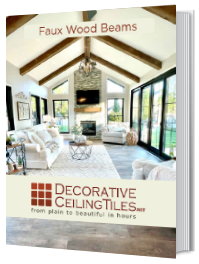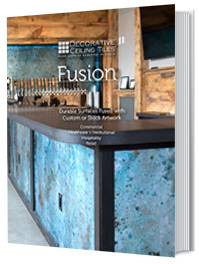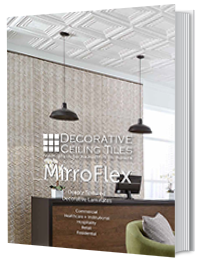Why you should consider a Beadboard Ceiling
Written by Milan Jara on 10th Sep 2024
Upgrade to a Beadboard Ceiling
Design trends come and go far quicker than many people realize, with some unique interior design choices looking great at first, only to end up making a room look tired and dated after a few short years. Your avocado bathroom tiles and popcorn ceilings may have stood at the forefront of trendiness for some time, but how well do they stand up to modern sensibilities?
Coming to the realization that your home or business could do with a facelift is only part of the equation, after all, renovations are rarely cheap. For many property owners, the thought of removing, reworking and replacing tired materials can be a significant time-sink in and of itself, stealing energy (and finances!) away from more pressing issues and responsibilities.
What if there were an easy fix? What if you could simply mask some of the more unsightly aspects of your property with a timeless, hard-wearing and easy-to-install finishing material? To find out more, let’s discuss why you should consider a beadboard ceiling for your space.
What is beadboard?
Beadboard is a timeless style of wall and ceiling paneling that uses vertical strips of material and indented, or beaded, overlaps to provide a protective and visually distinct finish to tired and worn surfaces. Traditionally, beadboard panels were formed from long and thin strips of heavy wood, but modern beadboard ceiling panels can be made from a variety of materials.
For example, we currently stock both PVC and styrofoam beadboard ceiling panels in a wide range of colors and designs. The benefit being that individual panels can be easily installed in the same way as a standard set of decorative tiles, removing the cumbersome aspects of handling heavy panels and providing the durability and upkeep benefits of modern materials.
What is a beadboard ceiling?
A beadboard ceiling is an interior roof of a commercial or residential property that uses a set of ceiling beadboard panels to produce a practical and visually appealing finish. Beadboard for ceilings can be used to mask unsightly blemishes and outdated finishing materials with a fresh and easily-maintained surface that also provides a little extra heat and noise insulation.
Why choose beadboard ceiling panels?
Choosing to install a beadboard panel ceiling can bring about a number of brilliant benefits for home and business owners. Not only can the visual appearance of beadboard on ceilings evoke the homely and welcoming aesthetics of a traditional New England cottage, it can also offer a cost-effective, easily-installed and simple-to-maintain alternative to plaster and paints.
High durability and low maintenance
PVC beadboard ceiling panels, unlike many wooden and metal materials, are both fire and water-resistant, while also being less prone to cosmetic damages like scratches and fading. You can also worry less about pest infestations, as PVC and styrofoam beadboard ceiling panels are far more resistant to insects and critters than traditional wood beadboard planks.
Like other types of PVC ceiling tiles, beadboard ceiling panels are incredibly easy to clean and maintain. If any dust or dirt does take hold, you can simply wipe your panels down with a damp cloth and they’ll look good as new. This can be particularly beneficial for business owners, as floor to ceiling beadboard walls can be thoroughly cleaned in a matter of minutes.
Cost-effective and customizable
Finishing any large surface in a home or business to a professional standard will always be fairly expensive, but choosing to install beadboard ceiling panels can offset some significant costs. Not only are the tiles themselves pretty affordable, but due to their lightweight design and glue up installation requirements, they can be easily installed by any avid DIY-er.
Beadboard ceiling panels are also highly-customizable, with countless options available in terms of colors, patterns, and textured finishes. Additionally, if you do get tired of your living room beadboard ceiling, or are simply looking to freshen up your design choices, removing and replacing any existing panels can be easily performed without professional assistance.
Excellent at masking imperfections
Sometimes, interior design is as much about compromise and efficiency as it is about finding the perfect visual aesthetic. Thankfully, opting for a beadboard panel ceiling can help you to achieve both of these goals. Rather than toiling away to fix small indents, cracks and lumpy plaster-work, simply install a clean, fresh and uniform beadboard ceiling below your old one.
This can be particularly time and cost-effective for masking any full-surface installations that you’ve become tired of, like popcorn ceilings or textured paints. Instead of taking on the long, messy and expensive task of removing and replacing said materials, you can instead opt for a bespoke set of beadboard ceiling panels that perfectly compliment the rest of your space.
How to install a beadboard ceiling?
Beadboard ceiling panels are, by design, incredibly easy to install regardless of whether you have any previous DIY experience. Due to the lightweight nature of PVC and styrofoam tiles, they can be secured directly to existing ceiling foundations using any standard tile adhesive, enabling you to produce professional and eye-catching installations in only an hour or two.
A typical beadboard ceiling installation will require the following tools and materials:
- Utility knife
- Tile adhesive
- Caulk
- Measuring tape
- Chalk line
What’s a good beadboard ceiling installation process?
Beadboard ceiling panels are best-installed from the center point of the room outwards, as this helps to ensure the installation is symmetrical. Find the center point of each wall and make a small mark in the ceiling for reference. Tie a chalk line to each of these center points and snap the line against the ceiling to produce a handy visual guideline for you to follow.
Next, apply dime-sized dabs of tile adhesive spaced around 6” apart to each beadboard ceiling panel. Starting from the center of the ceiling, and following your previously marked chalk line, simply affix each tile to the surface making sure to fit them as snug as possible.
If any gaps are present, you can use a little color-matching caulk to fill the empty space. If any openings need to be made for light fixtures or ventilation ports, you can simply cut your beadboard ceiling panels using a sharp utility knife. For heavier beadboard ceiling panels, you may choose to nail them to the ceiling, but you can still follow the same general process.
How to install 4x8 sheets of beadboard on the ceiling?
4x8 sheets of beadboard are much larger than standard 20”x20” beadboard ceiling panels, so your installation process may need to be adjusted slightly. As these types of panels are much heavier, it’s advisable to consider nailing up the perimeters alongside adding standard tile adhesive to the body of each panel, this helps ensure a secure and smooth installation.
You should also have a couple of people with you to help lift and affix these types of panels to your ceiling, as the added size and weight can make performing a solo installation a little dangerous. Aside from these considerations, you can follow the same process as covered above to measure out your installation and secure your beadboard ceiling panels in place.
How to cover popcorn ceilings with beadboard
One of the most popular uses of beadboard ceiling panels is to cover outdated or unsightly installations like textured paint and popcorn ceilings. The latter of these can be particularly tricky, as removing popcorn ceilings is not only messy, it can also be harmful to your health.
Scraping off a popcorn ceiling releases fine particles into the air that can cause health issues if inhaled, especially if the installation pre-dates the 1991 ban on asbestos in construction. To be safe, just install beadboard ceiling panels directly to the ceiling using the process outlined above, or consider hiring tradespeople to install a drop ceiling from which to hang your tiles.
Wrapping up
Whether you’re tired of looking up at the same outdated and unsightly ceilings in your home, or looking to spruce up the interior of your business, beadboard ceiling panels can be a great choice. Not only are they lightweight and easy-to-install, they’re also incredibly easy to clean and maintain, with great added benefits in the form of fire, water and pest-resistant qualities.
Beadboard ceiling panels come in a wide variety of stylish colors, patterns and textures, with options to suit just about any interior design choices. If you’re looking for some inspiration to start planning your own beadboard ceiling ideas, follow this link to browse our exciting range.
















